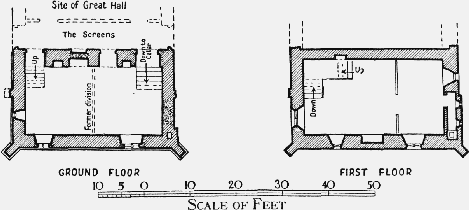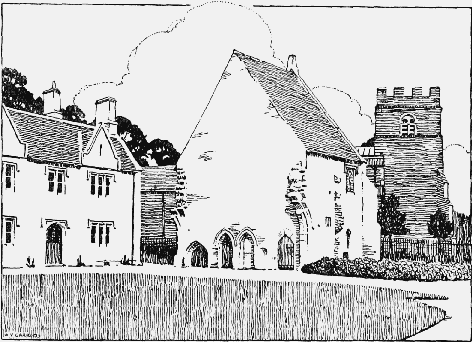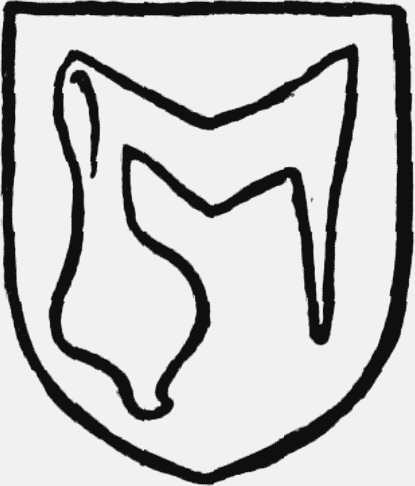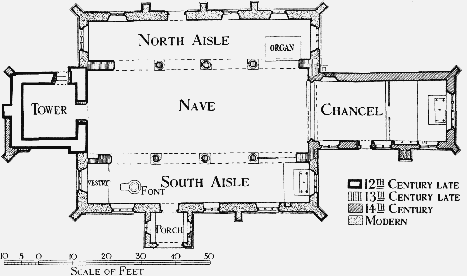A History of the County of Northampton: Volume 4. Originally published by Victoria County History, London, 1937.
This free content was digitised by double rekeying. All rights reserved.
'Parishes: Yardley Hastings', in A History of the County of Northampton: Volume 4, ed. L F Salzman (London, 1937), British History Online https://prod.british-history.ac.uk/vch/northants/vol4/pp296-300 [accessed 19 April 2025].
'Parishes: Yardley Hastings', in A History of the County of Northampton: Volume 4. Edited by L F Salzman (London, 1937), British History Online, accessed April 19, 2025, https://prod.british-history.ac.uk/vch/northants/vol4/pp296-300.
"Parishes: Yardley Hastings". A History of the County of Northampton: Volume 4. Ed. L F Salzman (London, 1937), British History Online. Web. 19 April 2025. https://prod.british-history.ac.uk/vch/northants/vol4/pp296-300.
In this section
YARDLEY HASTINGS
Gerdelai (xi cent.); Gerdeleia, Jerdele (xiii cent.); Yerdele Hastinges (xiv cent.).

Plan of Yardley Hastings Manor House
The parish of Yardley Hastings lies on the border of Buckinghamshire on the road from Bedford to Northampton. The soil is clayey on a subsoil of clay and limestone and the chief crops are cereals. The area is 4,187 acres of land and 3 of water. The population in 1931 was 796. The village lies to the north chiefly between 200 ft. and 300 ft. and southwards the land rises to about 370 ft. Yardley Chase, in the southern half of the parish, consists of a deer park and a number of woods noted for their timber including oaks of great size; most of these have been cut down in recent years, but Cowper's Oak, (fn. 1) associated with the poet, and Gog and Magog still stand.
The rectory house was rebuilt in 1701 by the Rev. Humfrey Betty. It is a large stone house with welldesigned red brick front, standing at the north end of the village, but was sold in 1935, and a new house erected on another site. A cottage on the south-west side of the churchyard bears a tablet inscribed R. W. 1676, and in the village is a large stone barn dated 1699. (fn. 2)
The remains of the old manor-house, which stand immediately to the north of the church, show that it was a house of some importance. They consist of what were evidently the buttery and pantry, with a large room over them, forming the southern end of the original house. To the immediate north of the present building was the entrance passage or 'screens' and beyond this, northwards, was the Great Hall, which has entirely disappeared. Excavations show, however, that it must have been some 45 ft. long, by 30 ft. wide, (fn. 3) the width of the rooms that are left, the whole building being roofed in one span. The original roof remains over what is left. The jambs of the doors of the entrance passage have survived and show that the main entrance door was on the west front, as this jamb is well moulded, while that of the door at the opposite end is only double-chamfered. In the right-hand wall of the passage, that is the north wall of the remaining building, are four doorways, of which the two in the middle are handsomely treated and opened into the buttery and pantry. Of the other two, one, of plainer character, led to a wooden staircase to the upper chamber; the other at a lower level (and apparently of later date) served some steep stone steps down to a cellar.
So far the arrangement accords with the customary plan. The entrance, or screens, had the kitchen department on the right and the great hall on the left. But there are no remains of the kitchen itself. However, there are indications that a portion of the east wall of the ruin has been rebuilt, and it is quite possible that the kitchen was approached through this wall after passing through the pantry. The upper floor presents an unusual feature, for it consisted of one large room (subsequently divided into two), open from floor to roof. The roof is handsome and was clearly intended to be seen. It is partly supported by a stout oak principal shaped into a flat-pointed arch, and the purlins have curved wind-braces. On the outside of the west wall are remains of a buttress where the principal rests on the wall. An attic story has at some time been contrived over the room, but originally it must have been a fine lofty apartment with a wide open fire-place in the middle of its south wall. In the thickness of the east wall is contrived a garderobe, ventilated by two small quatrefoil openings. The shaft is also ventilated by a narrow slit in the angle where the corner buttress joins the south wall. From the character of the room the inference is that it was the solar, or lord's private room, but it was not usual to place the solar over part of the kitchen premises with its approach from the screens. As a rule this chamber was at the farther end of the hall, away from the entrance and forming part of a group of family rooms. But the hall has been entirely destroyed and there are no indications of any rooms at its northern end. The windows of the ground floor are probably of early-14thcentury date, as well as one on the upper floor, the other windows being some years later, as also is the chimney shaft. One of the early windows has been altered about 1600. It is not easy to give a clear history of the various building operations to account for the difference in date of the windows and of the doorways leading from the screens. Some year or two ago the ivy was judiciously stripped from the walls, which were put generally into a state of repair.
Manor
This manor with its members in Grendon, Whiston, Denton, Hackleton, Horton, Wollaston, Brafield, Quinton, and Hardingstone was held before the Conquest by Earl Waltheof, to whom William I married his niece Judith. In 1086, as Countess of Huntingdon, she held 3½ hides in YARDLEY. (fn. 4) Her daughter Maud married as her second husband David, afterwards King of Scotland, (fn. 5) who in the 12th-century Survey is named lord of 7 hides less 1 small virgate in Yardley and Grendon. (fn. 6) From him this passed with the honor of Huntingdon successively to his son Henry, stepson Simon de Senlis, and grandsons Malcolm, William, and David. (fn. 7) In 1190 Richard I renewed to Earl David, among other liberties originally granted by Henry I to his grandfather David, King of Scotland, full rights in his hay of Yardley with venison and warren, (fn. 8) which were renewed to his son John, Earl of Chester and Huntingdon, by Henry III in 1233. (fn. 9) Earl David died at Yardley in 1219 but was not buried there. (fn. 10) In 1234 the barons and knights of Earl John were forbidden to hold a tournament at Yardley. (fn. 11) He is thought to have been poisoned by his wife Helen, daughter of Llewellyn ap Iorwerth, Prince of North Wales, in 1237, (fn. 12) and after his death Yardley was assigned to the pourparty of his sister Ada the wife of Sir Henry de Hastings of Ashill, Norfolk, the ancestress of the Lords Hastings from whom it derived the name of Yardley Hastings. (fn. 13)

Yardley Hastings: The Manor House

Hastings. Or a sleeve gules.
Sir Henry de Hastings died in 1250, (fn. 14) when the manor of Yardley was granted to Guy de Lusignan the King's brother, during the minority of his son and heir Henry, (fn. 15) who had livery of his lands in 1256. (fn. 16) He was wounded and taken prisoner when fighting for Simon de Montfort at Evesham in 1265, and his manor of Yardley, worth £90, was committed to John de Warenne, but the King allowed his wife Joan, daughter of Sir William de Cantelou, to retain certain of his lands elsewhere. (fn. 17) Being excepted from the 'Dictum de Kenilworth', he was subjected to the fine of seven years' value of his estates, and he submitted to Prince Edward in 1267. (fn. 18) He died in 1269 and his son John had livery of his lands when he came of age in 1283. (fn. 19) In the following year Sir John de Hastings was found to hold Yardley of the King in chief. (fn. 20) He was created Lord Hastings in 1290 and died in 1313 seised of the manor, which passed to John his son by his first wife Isabel, daughter of William, Earl of Pembroke. (fn. 21) In 1314 the King granted to Sir John de Hastings and his heirs a weekly market on Wednesday in their manor of Yardley and a yearly fair there on the vigil, feast, and morrow of Holy Trinity. (fn. 22) When Sir John died, in 1325, the manor included two dovecotes, a wind-mill, a horsemill, a park, and a free chace, with two yearly views of frankpledge and a three-weekly court, and was held of the King in chief by service of a sore sparrow-hawk or 2s. yearly. (fn. 23) During the minority of Laurence, son and heir of John de Hastings by his wife Juliana daughter of Sir Thomas de Leybourne, custody of the manor was granted to various persons. (fn. 24) Though still a minor, Laurence de Hastings had livery of his lands in 1339 when he was created Earl of Pembroke. (fn. 25) On his death in 1348, leaving his son John by Agnes, daughter of Roger Mortimer, a minor under two years, (fn. 26) custody of the manor was granted to William de Groucy. (fn. 27) This John de Hastings enfeoffed Walter Amyas and others to certain uses and died in 1375 (fn. 28) leaving his son John aged two, to whom in 1387 the feoffees quitclaimed the property. (fn. 29) He was accidentally killed at the age of 17 in a tournament at Woodstock in 1389, when the Earldom of Pembroke became extinct. (fn. 30) The estate passed to Reynold, Lord Grey of Ruthin, the grandson of Elizabeth daughter of John, first Lord Hastings. (fn. 31) He was holding one knight's fee in Yardley in 1428 (fn. 32) and in 1440 was succeeded by his grandson Edmund, the son of Sir John Grey, (fn. 33) who was created Earl of Kent in 1465 and died in 1490. His second son George, Earl of Kent, died in 1503 having entailed his property, (fn. 34) but it was dispersed, probably through the gambling propensities of Richard, his son by his first wife Anne, widow of Sir William Bourchier. Richard, Earl of Kent, conveyed his lands to feoffees to the use of himself and his wife Elizabeth, with remainder to her brother Lord Hussey. (fn. 35) After divers transactions the manor and remainder were sold to Sir William Compton in 1512–13. (fn. 36) He died seised of it together with the park and chase in 1528, (fn. 37) from which date it has followed the same descent as that of Castle Ashby (q.v.).

Plan of Yardley Hastings Church
In the 18th century a fair was held here on Tuesday in Whitsun week in a close adjoining the old manorhouse. (fn. 38)
The FREE CHASE of Yardley was usually made the subject of a separate grant during the nonage of an heir. Henry III's brother Richard, King of Almain, held it in 1271. (fn. 39) In 1345 the king confirmed a grant which Laurence de Hastings had made to his yeoman Robert Wyard, of the bailiwick of the manor and custody of the chase, with wages at 3d. a day, a robe and fees. (fn. 40) A wood here called 'Roundehai' in 1325 (fn. 41) is mentioned again in 1530 when it was granted with the bailiwick of the manor to Baldwin Willoughby, Sewer of the Chamber. (fn. 42)
Church
The church of ST. ANDREW consists of chancel, 37 ft. 4 in. by 17 ft. 6 in., clerestoried nave of four bays, 63 ft. 4 in. by 24 ft.; north and south aisles, about 11 ft. 6 in. wide; south porch, and west tower, 16 ft. by 15 ft. 6 in., all these measurements being internal. The width across nave and aisles is 52 ft. 6 in.
The south aisle and porch were rebuilt in 1883, the north aisle in 1887–8, and other modern work includes the restoration of the chancel (1884–5) and clerestory, and the erection of new roofs. The walls throughout are of limestone rubble, but in the parts rebuilt ironstone is used for windows and dressings. The chancel has a slated eaved roof, but the other roofs are leaded and of low pitch, that of the nave behind straight parapets. The aisle parapets are battlemented. With the exception of the tower all the walls are plastered internally.
The tower is of late-12th-century date, but everything east of it has been rebuilt, the nave arcades dating from c. 1280–1300, and the chancel from c. 1340. The rebuilding appears to have been begun by the erection of an aisled nave, the width of which was determined by the great size of the tower, followed at an interval by the erection of a new chancel and the widening of the aisles, the architectural features of which before their modern rebuilding were in the main similar to those of the chancel. (fn. 43) The clerestory appears to have been a 15th-century addition.
The chancel has diagonal angle buttresses of two stages, chamfered plinth, and a string at sill level along the east wall. The 14th-century pointed east window is of four trefoiled lights with reticulated tracery, and the gable has a plain coping and modern apex cross. The north wall is blank. In the south wall are three square-headed windows of two trefoiled lights, with hood-moulds and double sunk-chamfered jambs, the westernmost of which is lengthened so as to form a low-side window. (fn. 44) Opposite to this, in the north wall, are the remains of a second low-side window, entirely blocked outside, but with its western light only dropped, as at Grendon, the sill being stepped inside. (fn. 45) The piscina is wholly restored, and the triple sedilia very extensively. The former has a cusped ogee arch in a square head, and the latter are at one level, under cinquefoiled ogee arches on shafts and jambs with moulded capitals and bases. (fn. 46) There is a plain pointed priest's doorway between the two westernmost windows. The wide pointed chancel arch is of two chamfered orders, the inner springing from half-octagonal responds with moulded capitals and bases. (fn. 47)
The late-13th-century nave arcades consist of four pointed arches of two chamfered orders springing from octagonal pillars with moulded capitals and bases, and from moulded corbels at each end. The arches have hood-moulds on the nave side, but there are differences both in dimension and detail (fn. 48) which point to the south arcade having been built first. Several ancient features have been retained in the modern aisles. In the usual position at the east end of the south aisle (which was restored to use as a chapel (fn. 49) in 1905) is a trefoil-headed piscina with fluted bowl, and on each side of the east window a carved bracket. There is no piscina in the corresponding part of the north aisle (now used as an organ-chamber and vestry), but in the north wall is a rectangular aumbry (fn. 50) fitted with a modern door.
The clerestory was wholly restored when the new roof was put on the nave in 1889. It has five modern square-headed two-light windows on the south side, and four on the north, all of the same character as the other windows in the church, but placed without reference to the arches below.
The massive late-12th-century tower is of three stages, marked by strings, and terminates with a later battlemented parapet. Diagonal buttresses at the western angles are also later additions, (fn. 51) but there are original buttresses at the east, facing north and south, and in the middle of the west wall. The lower stage is blank on all three sides, except for a doorway (fn. 52) knocked through the north wall, and the middle stage is also blank on the north, but on the south and west sides is pierced by tall loops. (fn. 53) The bell-chamber windows consist of two rounded lights with solid spandrel, under a semicircular containing arch on jamb-shafts with moulded capitals and bases. On the south side there is also a small round-headed opening (fn. 54) east of the main window, and on the east face of the tower is the line of the original high-pitched nave roof. Immediately over the bell-chamber windows, on all four sides, is the corbel table, mostly of carved heads, which carried the original parapet. The tower is walled off from the church, but a plain 13th-century doorway, which retains traces of colour decoration, gives access from the nave. There is no vice.
At the south-west corner of the nave a squareheaded recess marks the position of a doorway to a former west gallery. The west end of the south aisle is screened off with good 18th-century panelling. The south doorway retains an original oak door, relined. The door, which may be of 15th-century date, contains a wicket, and has a trefoiled head, embattled top rail, plain iron hinges, and good ring handles.
The font has a plain octagonal bowl, and good 17th-century flat panelled cover with knob. The oak pulpit is modern. There is no ancient glass. (fn. 55) The royal arms of the later Hanoverian sovereigns are in the nave, and there is also a brass chandelier of eighteen branches given in 1808 by George Rooke, rector. (fn. 56)
There are wall memorials in the chancel to John Wilson, rector (d. 1695); Humfrey Betty, rector (d. 1737); William Underwood, 'many years Postmaster of Oxford, Witney, and Burford' (d. 1760); (fn. 57) Edward Lye, rector (d. 1767); James Gardiner, rector (d. 1799); George Rooke, rector (d. 1856); and others. In the north aisle is a memorial to thirty-one men of the parish who fell in the war of 1914–18. A lych-gate was erected in 1902.
There is a ring of six bells, cast in 1723 by Henry Penn of Peterborough. (fn. 58)
The plate consists of a plated cup and silver paten given by the Rev. G. H. Rigby, rector, in 1892, and two plated patens and a flagon, all inscribed 'Yardley Hastings'. (fn. 59)
The registers before 1812 are as follows: (i) all entries 1550–1653; (ii) 1653–1700; (iii) baptisms and burials 1701–1812; (iv) marriages 1754–87; (v) marriages 1787–1812.
Advowson
The earliest known patron was the prior of the Hospital of St. John of Jerusalem in England who presented to the living in 1232, (fn. 60) but the right was recovered by William de Valence and Guy de Lusignan who had custody of the manor during the minority of an heir, and they presented William de Sexthorp in 1251. (fn. 61) From this date the advowson descended with the manor. When assigned to Agnes, Countess of Pembroke, in 1349 it was extended at 40 marks yearly. (fn. 62) Richard, Earl of Kent, appears to have assigned it to Edmund Howard who presented Master Robert Carter in 1519, (fn. 63) but it was acquired by Sir William Compton before 1528. (fn. 64) A grant of the tithes of the demesne of Yardley to the prior of St. Andrew's, Northampton, by Simon de St. Liz was the cause of later friction between the prior and the rector. (fn. 65) In 1223 it was agreed that the latter should pay 9 qrs. of wheat and one bezant worth 2s. in lieu of tithes (fn. 66) and this was ultimately converted into a pension, stated in 1535 to be 26s. 8d. (fn. 67) At this date the rectory, valued at 20 marks in the 13th century, (fn. 68) was rated at £15 13s. 2¾d. and included Denton. (fn. 69)
John Towers, afterwards Bishop of Peterborough, was instituted rector here in 1623 and had dispensation in 1628 to hold with Yardley the vicarage of Halifax. (fn. 70) Edward Lye, Anglo-Saxon and Gothic scholar and Fellow of the Society of Antiquaries, was presented to the church by the Earl of Northampton in 1750 and was buried here in 1767. (fn. 71)
Charity
Andrewe's Dole. An annuity of 4s. was given or settled in 1619 by William Andrewe for the benefit of six poor widows, but the payment of the annuity has long been withheld and must be regarded as lost.
According to the ancient 'customes' recorded in 1607 the rector had to give a Christmas dinner to the town, and also to provide straw in the church at Easter and Christmas 'that parishioners might be warm in church with comfort to hear God's word.' (fn. 72)